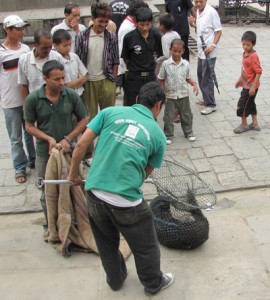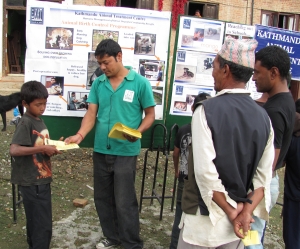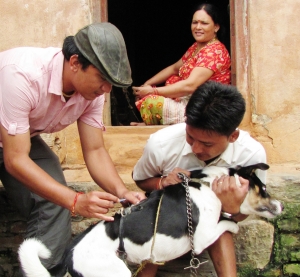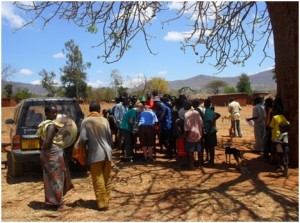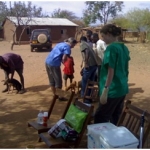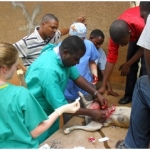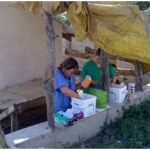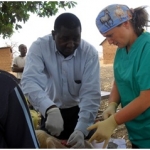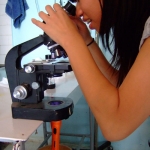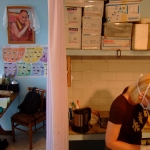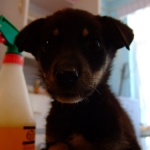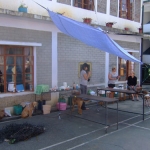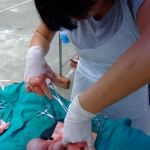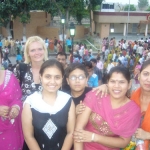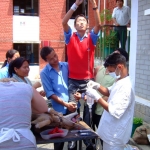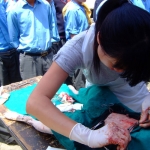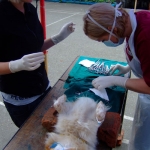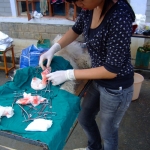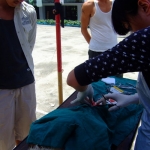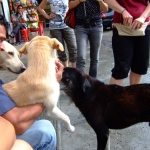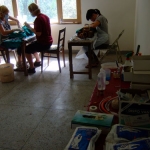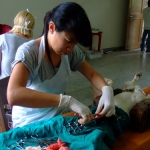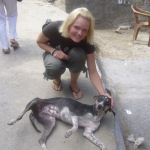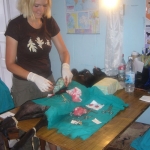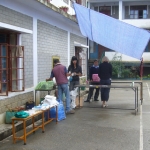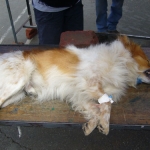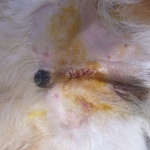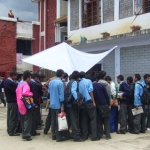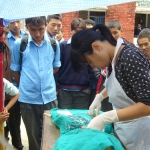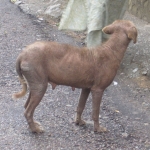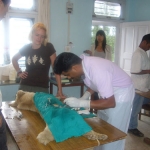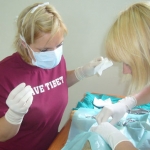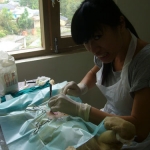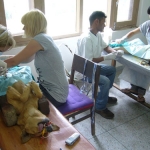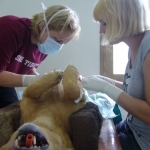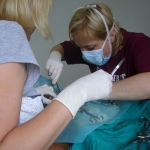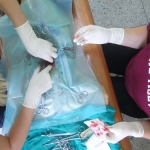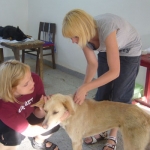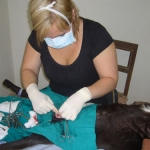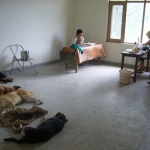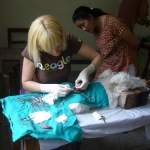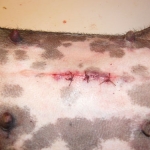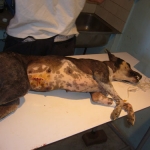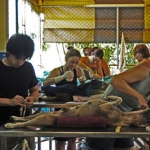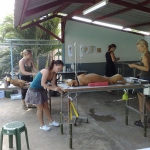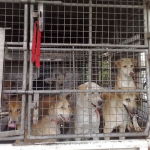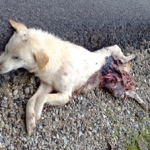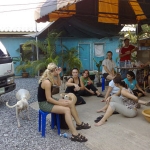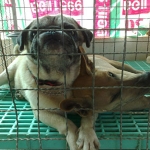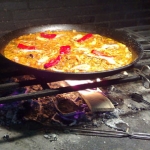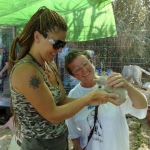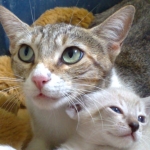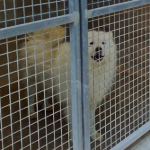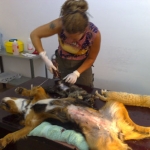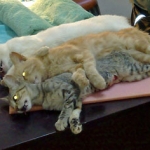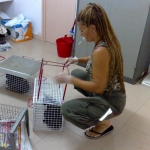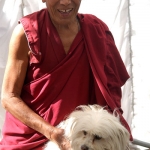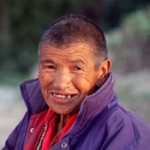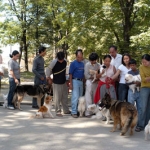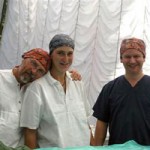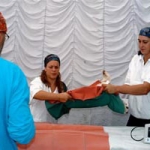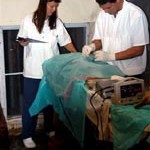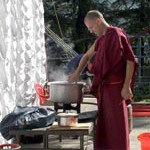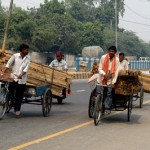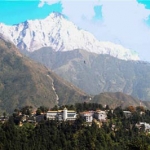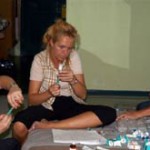By Veterinarian Mogens Østergaard Hansen
Two years ago, we were operating on dogs on marble table tops in a Coca Cola warehouse in the middle of a Tibetan exile area in South India. Now, we are operating on dogs on wooden tables in a big party tent in the Himalayas! What woul happen next?
The project
What went before this was a brief time after our return from India in 2001; we were strongly requested to make a similar project in Dharamsala in North India. This area is H. H. Dalai Lamaxs home, all of the Tibetan administration for exile Tibetans and roughly 8000 Tibetans.
There were several reasons for them to want us to work on a new project. Partly because of the positive feedback from South India where the health of the dogs improved, which can be seen on better coat and skin quality. Also that it was clear that not nearly as many puppies were born because the parent generation had been neutralized. And partly the residents in the area had got another attitude to the dogs and took better care of them.
But the primary reason for this project was that every year Tibetan children in Dharamsala die of rabies caused by dogs.
This was a change compared to our last trip because there was not rabies in the Tibetan area in South India. So besides treating the dogs for parasites, neutralize them, give them microchips and check their health it was also necessary to inoculate them against rabies. This caused some professional thought. Did it have any effect at all to inoculate the dogs? Based on considerations that included that it is a fairly closed population of dogs in a mountain area, we decided to put it to the test.
The authorities in Dharamsala had in addition a wish to inoculate the dogs against rabies because tourists often stayed away from the area. A lot of tourists are afraid of going to the area because of rabies and therefore it is important to re-establish trust.
The preparations
The preparations for the trip were a bit easier this time. We had experience from the previous trip and we had left behind some equipment down in South India that we had sent to Dharamsala. Our experience with the Indian customs, that had caused us trouble last time, made us send packages with medicine to the area weeks before we traveled there. Because of the Indian postal service we were excited while we waited for the medicine to arrive to the area. Shortly before we were going to leave, we received news that only 5 out of 7 packages had arrived. Most of these packages had been destroyed and medicine was missing from some of them. For example had the bottle with vitamin B been crushed which made everything in that box brown and sticky. In addition to that, some Tibetan persons had placed the medicine in a lot of different places, which meant that we got mail regularly saying they had found some medicine here and there. Just before we left, we had to buy medicine for 10,000 Dkr. to replace the medicine that had not arrived, and of course we received a mail the day before we left, that finally some of the missing medicine had arrived. Typically Indian!
Experienced by the last trip we made sure to make a list of all our equipment this time, which we got verified on the Indian embassy. We spent a lot of time with this and it would turn out to be a waste of time. We had as mentioned some of our equipment from last time but we still needed a lot of new things. Almost all the medical companies we contacted were positive and either wanted to give us money or equipment. This made it a lot easier for us.
The trip
Like last time, we all met at Centrum Dyreklinik. We were a big group of excited people consisting of 7 veterinarians, 1 veterinary nurse, 2 helpers, 1 nanny and 5 lovely children between 5 and 10 years old. The spirit was high and it would last the whole trip. We did not bring a lot of baggage this time because some of the equipment and medicine were there already. We had limited our private baggage because the last trip had taught us that clothes were so cheap in India that it was crazy to bring a lot from home.
The flight: well, a lot of people, boring food, alternative sleeping positions and friendly flight attendants with big smiles. I spent a lot of time on a new gadget; the private TV monitors on the back of the seats. You can choose between a lot of channels, including a channel that shows take off and landing via a camera mounted in the front part of the plane. I would not recommend this channel for anyone with fear of flying because you can see all the planes that cross of the path of your plane while you taxi the runway. There was also a channel with a real Indian “Bollywood” movie, that is similar to an old American musical. The difference is that the big band music has been replaced by sitar and drums and the girls are a lot prettier.
Arrival
I used the last two hours before arriving at the airport in Delhi to prepare myself for the Indian customs. Last time in South India we used two days to get our confiscated medicine back but this time we had got fancy stamps on a lot of important looking papers from the Indian embassy. In addition to that I had prepared for anything that might happen. And what happens? We are waved right through customs by a slightly irritable and tired looking Indian customs officer. I felt both irritated and happy. Irritated because of all the work we had done and that they do not do their work but happy that we got through so fast. After all, it was 3 am and we had five tired children and a one hour ride to the hotel through Indian traffic.
The traffic
Something about the Indian traffic: You cannot describe it, it has to be experienced! A lot of Danish veterinarians have just been to a world congress in Bangkok and have experienced the traffic in Asia that can be chaotic. But compared to New Delhi the traffic in Bangkok is nothing. Besides driving faster and closer, there are also natural obstacles such as cows, carriages, beggars, potholes, dogs, goats and sudden and unexpected roadworks, hayloads, mopeds with three or four people, big polluting busses and trucks and a large number of people selling everything from newspapers to balloons. In addition to that the pollution is equal to sitting in a small room without ventilation filled with 400 smoking senior citizens playing bingo. We were told that you buy a driverxs license in India. Driving school is not a requirement. I would not call it a “driver’s license” but rather a “license to kill”. The taxi I was passenger in had an interesting feature that became useful when I wanted to lean back. It turned out that the passenger seat was not stuck to the floor and suddenly I was lying in the lap of my girlfriend, who was sitting on the back seat. Welcome to India!
The days in Delhi
Our hotel in Delhi was located in the Tibetan area. We were received in the airport by Tanzing, who is Tibetan and owner of a travel agency. When you enter the Tibetan area, it is like entering another world because it is very different from the hectic lifestyle in New Delhi. Small narrow streets with Tibetan stores, restaurants and hotels, bald Tibetan monks in their red habits and lots of pictures of H. H. Dalai Lama made the perfect scenery. Our hotel, The White House (we did not meet Bush!), was owned by a monastery and it is monks who run it. The food in the hotel is good and very cheap. Before we had to leave by train in the evening, we had a dinner that consisted of lots of chicken and lamb in various Indian spiced sauces, rice and bread.
In addition to that, we got momos that is Tibetan meat and/or vegetarian balls wrapped in a thin layer of dough and then steamed or roasted. It is similar to Dim Sum, wonton or ravioli. We were 16 people and paid 240 Dkr. for all of this including soft drinks, it was a non-alcohol area, and we could not even eat all the food!
The trip to our area
After a train ride in a in a sleeping car where most of us slept fairly well after a few beers and some swigs of good whiskey, we arrived to Patankot where we had to continue by bus. Traveling by bus in the mountains in India is for certain an experience you remember for a long time. There can only be one thing worse than driving up the mountains in an Indian bus and that is driving down! No crash barriers between the road and the abyss, big trees that have fallen onto the road where only a middle section has been removed so big trunks still stick out of the road. Holes the size of Volkswagens in the road, cows, monkeys and dogs that run around and other drivers who constantly are on collision course with the bus. To our surprise, we did not see any serious accidents while we were in India, only a few crashed trucks. But we heard about several who had driven into the abyss. There were two roads between our area and the government area. One was good but long. This was good under Indian circumstances but bad under Danish. My opinion is that it could be used as a fairly good and challenging downhill slope during the winter when it is covered in snow. The other road was shorter but a lot more dangerous because most of the road had been washed away by the monsoon. Several cars had driven into the ditch and the ditches are several hundred meters deep. The old song about Loch Lomond is true here: “I take the high road, and you take the low road” and “And wexll never meet again on the bunny banks of Loch Lomond”. In addition to that, the shock absorbers in Indian cars must have been exchanged for more powerful and advanced horns. Every time the cars hit one of the numerous holes in the road, it felt like being kicked in the as.. by an angry bull.
The actual area
The geography in the area is that Dharamsala is divided into three areas which are located in different altitudes. Lower Dharamsala is located in approximately 1000 m above sea level and is an Indian city. Further up the mountain is the administration area with the government building where the Tibetan exile government frequently has meetings. Even further up the mountain, approximately 1800 m above sea level, is Upper Dharamsala or McLeod Gonj, which is almost completely Tibetan. The area is named after a British colonel who liked being in this area. During the colonization, many people from Britain lived in Northern India, especially in the summer, because it is very hot in the Southern areas of India, like in Delhi and Mumbai (Bombay). It is also in this area that Dalai Lama lives, close to a monastery in a humble small house surrounded by security guards. Further up the mountain is Tibetan Children Village, that is a big school area, where about 2,000 Tibetan refugee children live in a community home far away from their parents.
McLeod Gonj is basically made of two parallel streets that are very narrow. There are a large number of stores that sell all kinds of crafts. There are crafts from Kashmir, such as figures made of rice paper, shawls and clothes. When I was in Kashmir 28 years ago, it was a brisk tourist area where they sold their beautiful crafts, for example in Srinigar that is perhaps located in the most beautiful area in the world. If you have been on a houseboat on Dal Lake and experienced the view of the lake with the red mountains in the background, that are the first of the Himalayas, well then you do not need to experience anymore. You cannot describe how it is to sit there with a cold beer and with kingfishers sitting next to you while you look at lotus flowers and boats that look like gondolas. The city is also called “Venice of the East”. But because of religious disturbances they have to sell their crafts in other tourist areas such as in Goa and Dharamsala. Of course you can also find Tibetan crafts, such as knitted jerseys, skirts and socks, in Dharamsala and also stores with Indian crafts like jewellery, cloth, silver and religious figures. H. H. Dalai Lama’s presence is evident in the city. In addition to the many stores that sell books and picture of and by Dalai Lama, you can find his picture everywhere, in stores, restaurants, cafes and hotels. The streets are full of people, cows, dogs, beggars and every type of vehicles from carriages to tuk-tuks (3-wheeled scooter taxis), busses and trucks. The roads are very uneven and the stores can look from very nice and somewhat luxurious to a stall that has been put on the side of the road. If you look up, you can see power cables that look like a ball of yarn a cat has played with. It is amazing the electric system is working at all.
But even if there are many similarities between other Indian cities and McLeod, it is an exciting change from Delhi. The air is fresh and the scenery is beautiful. The view of the valley and the mountain is very beautiful and perhaps the most beautiful I have seen. And I have been in most of the mountain areas in Europe. In addition to that the city is much more calm and pleasant to live in. Life is not as chaotic and hectic as in New Delhi. It is without doubt that Dalai Lama has a lot of influence on this area.
The Tibetan Children Village
I simply have to tell a little bit about this area. In 1959 Tibet was in chaos. The Chinese invasion that had begun several years before became violent this year with killings of Tibetans and monks and lootings and destructions of temples. A lot of people tried to escape from Tibet and children were separated from their parents either during the escape or because their parents had been killed or taken prisoner by the Chinese. Because of this it was a large group of sick and unhappy children that came to India without parents. When Dalai Lama heard about this, an area in Dharamsala was created where the children could get treatment, education, food and clothes. In the next years this area expanded and lots of children from Tibet were smuggled out of India without their parents by a network, and they were often followed by monks and nuns who carried the children on the back across mountain passes 4 – 5000 meters above sea level in frost and cold. This may sound horrible in our ears but you should not forget that the Chinese occupying power try to destroy the Tibetan culture. This also happens in schools. Today Tibetans are a minority in their own country and all education in schools is in Chinese. You can compare it to the Indians in America and the aboriginals in Australia.
This future combined with bad educational possibilities make a lot of Tibetan parents send their children to Dharamsala to have a better future.
Today the Tibetan Children Village is a big area where the children can get education in their own language. A big effort is made to teach about Tibetan culture and the children practice music, dance and theater where Tibetan culture is the pivotal point. The children live in small groups with two adults who are teachers and xparentsx for approximately 35 children. The big children take care of the smaller children and the teachers are often former students who work for a small salary. The area has, as mentioned, approximately 2,000 children, which is close to 25% of the total population in the area. It is the biggest school area of the many schools that have been created in the many Tibetan exile areas in India. You can say many things about Indians but you have to respect that they let a foreign people get such a large territory without interfering in the way the Tibetans use the area. The areas are totally self-governed. And we cannot even let people from our own rich and spoiled country decide about their own tiny part of Denmark. Who said Christania?
The people
Most of the permanent residents are Tibetans who have a clearer and more sensible attitude to life than Indians. Agreements are kept, work gets done and you can have a sensible conversation with them. Indians promise a lot and nothing happens and they can get very angry if you point out these flaws. There are also lots of hippies who spend time in the many small cafes you find everywhere. Pot and other drugs are smoked in these cafes. Fair enough. What is not so fair is that some hippies go into the mountains with a large amount of money to buy pot and disappear forever. There are also a lot of Westerners who study Buddhism in the many monasteries you find in the area. We have heard of several foreigners who want to come and help us. The project has been mentioned a lot.
Lepers who beg are not an unusual sight and in the beginning this was a different experience for the children. People with missing body parts such as nose, fingers, hands, feet and legs can be frightening for children but after a few days they began to talk to the lepers and discovered that they were not different from the rest of us and that they were very sweet. Another reason why Tibetans are missing body parts is frostbite. Tibetans escaped over the mountains from India and during the escape they went through cold areas with snow and frost. They escape in very little clothes and because of that they get frostbite that causes gangrene in body parts. The monks often carry children on their shoulders for several weeks to get away from Tibet. They have to hide for the Chinese in mountain caves before they can continue their cold and painful journey towards freedom. We also visited the place that receives the refugees when they come from the border. Here they are given food and clothes, are treated for their sicknesses and get a bed in a big dormitory. It is thought-provoking to see them so positive and without bitterness when you keep in mind a lot of them have lost family in Tibet and had to escape from their mother country because of the Chinese. And it is impressive that Dalai Lama greets every single fugitive.
In addition to that, the whole area is marked by the monasteries that are located in the area because there are lots of monks and nuns in the city. It is a bit strange to see the monks use mobile phones and go to internet cafés.
Our hotel
Our luxury hotel, that was without a doubt the most expensive in the area, was a special experience. The most positive you can say about it is the breathtaking view of the Himalayas. But the carpet in the hall outside our room was patched with other carpets. The room was a story in itself, especially the toilet. Boring furnishing, pale green walls without decoration and with boring furniture. The bathroom was hopelessly out of date with running faucets and fittings that did not work and were loose. The tiles had been laid by a drunk person on drugs and joints were no where to be seen. Service was miserable and things did not get fixed even after several enquiries. However, this is fairly normal when you talk to Indians. The bartender was wasted around 9 pm and we had to get a guard to translate his nebulous talk, and in the restaurant you almost had to go to the kitchen and get your food and drinks yourself. On the menu you could find “Choice of beer and ice cream”. But this basically meant “We choose for you” because most of the time they did not have more than one kind of beer and no ice cream. However, with a price of 90 Dkr./day we did not want to complain too much and the hotel did have positive things. For instance, three of our rooms got an alarm call at 6:50 am one morningx without booking it. You can call that service above the usual!
Our work places
But we had gone there to work and not to relax in a luxury hotel. So the day after we had arrived, we went to The Health Department that had our things from our project in South India and also the packages we had sent from Denmark. Well at least most of it because some of it had not arrived. We had also bought a fridge for our medicine (and especially our beer). We were going to work in four different sites in different altitudes.
The first place had been carefully chosen. It was an open space with asphalt right next to our hotel with the wonderful view of the Himalayas. The next place was in Lower Dharamsala, in an Indian area, because the Tibetans would like to show gratitude to the Indians who had shown a big interest in our project. Because of that the Tibetans had promised we would work there. We were supposed to work there for 5 days, then it was changed to 2 days, and suddenly they wanted 4 days after all, but not when we had planed it. So we said stop, we would be there two days as previously decided.
After that we went to Nobeling that is Dalai Lamaxs old summer palace. Nobeling was also the name of Dalai Lamaxs summer palace in Tibet but after the Chinese invasion and the Tibetans escape from Tibet, a new summer palace was built in India. However, Dalai Lama thought it would be more useful as a museum and workshop. A small Tibetan society with homes for handicapped children has been built up around this beautiful palace with gardens and small waterfalls.
The next place was going to be in “Tibetan Children Village” as I mentioned previously and we would finish in The Health Department where the government building was.
The work
We returned to McLeod Gonj after getting all our medicine and equipment and we saw they made our tent ready. It was a big tent, four meters from the floor to the ceiling. They put electricity and tables and water was arranged. It was actually a big tent for weddings with tables and chairs that we had been able to borrow. We spent the next hours with sorting the mess and make a work schedule for everyone. Spirits were high and everyone was excited to begin and everyone knows what his/her tasks were, even the new people on the team.
We divided the tent into three rooms: two small rooms for registration and preparation and a big room for operations with five operation tables. This time we got tables used for parties that were worn and with nails sticking out everywhere. But at least the dogs would not slide down from the tables. In addition to that we had to put rocks under the table legs to make them tall enough but they were still taller than last time. The Tibetans from The Health Department had arranged for guards outside the tent during the night. They also had to keep an eye on the dogs that still were tired in the night and feed them when they were fit enough. The Tibetans also cleaned after us but we had to stop them from pouring wash water into our electrical installations on the floor.
Everyone arrived in work clothes and scarves. Lasse had bought colored scarves on the market that we could use on our heads instead of operation caps. So “Dyrlæger Uden Grænser” got a new nickname: “Bandito-vets”.
Nothing really happened before 11 am which surprised us but it turned out that an official person would come and make a real opening of the project with a speech, cutting of a red tape (one of our own leashes!) and recording of a TV program with interviews. So we had people from TV running around in the OR and other places all day.
Our first patient was one of our Indian dog catchers who had been bitten in arms and legs. All our helpers had been vaccinated against rabies so he only needed a revaccination. The wounds were treated and he got antibiotic.
People came with several dogs in trucks, tuk-tuks, private cars and even by foot. Monks and Westerners would walk up the mountain from far away with dogs in their arms.
There was a long line of private dog owners who primarily wanted their dogs vaccinated. There were Indians, monks, Tibetans and resident Westerners from Lithuania, Japan, England and Tasmania. We vaccinated 125 dogs the first day and operated on (sterilized/castrated) 37 dogs. We also had a dog with symptoms of rabies that we had to put down. This time we had a special permit to put down hopelessly sick dogs that could not be helped and be a danger to people and other dogs. We had helpers from Canada, the US, England, Austria and Switzerland so we were an international team. All the removed embryos from pregnant dogs that were sterilized were given to our Canadian monk. At the end of the day, Josh a fully trained English monk who had been here ten years, was sent for to bless the embryos before they were buried.
During the next three weeks we traveled between the different areas and we came to vaccinate 600 dogs and operate on 260. The Tibetans were satisfied with this and dogs with color and a shaved spot on the back soon became normal in the city and a subject of conversation for both Tibetans and Indians.
Funny experiences
We had a very caring “dog granny”. She was an old Tibetan woman with only a few teeth left but this was compensated for by the number of wrinkles in her face. She took care of approximately 30 dogs in her own house and she would turn out to spend almost everyday and night in our place to help the dogs. We did not understand any of her gibberish but she was good at gesticulating while she talked so it was not that bad after all.
One day we went to a Tibetan restaurant and we had just ordered the food when one of our night watches suddenly appeared in the middle of the restaurant. Exactly this night watch was on every known and unknown drug and therefore a bit difficult to understand when he spoke his already poor English. But it was about a dog that had problems with a wound and he wanted us to come and look at it. My fantastic veterinarian care for xall creatures great and smallx overcame my hungry stomach and I followed our night watch out who proved that spinal cord reflexes can handle a lot. Luckily the owner of the dog was right outside the restaurant so we did not have to walk all the way back to the tent. Because the dog was one of the small and aggressive papillon/terrier mixes I asked the owner to hold it. It did not go well when our slightly intoxicated night watch tried to hold it. He was bitten several times without noticing it and it made me wonder what combination of drugs he had been using so we could use it as anesthesia. In the end the owner took out a muzzle he had borrowed. After that I got a grip around the neck of the dog so firm that it relaxed (passed out) while it was muzzled. The night watch in his intoxicated state thought that I was not satisfied with his work and tried to punch me. After checking the wound and determined that it could wait to be fixed until next morning, I had to explain to the night watch that he should not try to punch me again.
The rest of the night went without problems and when we checked the tent and the dogs, we found the night watch feeding the dogs. It was impressive what he could do in his intoxicated state but I guess he has had many years of experience.
A Tibetan community home
One day we visited a community home for the poorest children in Tibet. This community home is only for children from a particularly place in Tibet. This place in Tibet was so remote that it had been isolated in many years and the residents had their own language and were illiterates. The place was discovered by two monks who were hiking and the place was also unknown to the Chinese. When Dalai Lama heard about the place he wanted to help. Because the children could only look forward to a poor life, the parents were offered to let their children go to a free community home. The offer made them happy and that is why the community home was built out of Dalai Lama’s own pocket. Since then a lot of sponsors have helped, including Tibet Charity in Denmark.
I had expected to see a dark and boring community home that was dirty and messy. But I was mistaken and how. Already in the school yard you could see it was nice and tidy and the buildings were beautiful. The tour began in the sick bay where colorful pictures of Donald Duck were hand painted on the walls. All the beds were tidy and the medicine was placed in alphabetic order in the medicine cabinet. We saw the dormitory where every bed was made so perfectly that even the strictest chambermaid in the best hotel in the world would be impressed. There were teddy bears on all the beds and it was so clean you could eat off the floor. And it was the same all over the community home. The children’s lockers were filled with their clothes, and where rooms of Danish children look something like the battlefield from World War one, here everything was arranged perfectly. And you have to mention that the children themselves washed, dried, folded and put their clothes in their lockers. They also washed the floors, made the beds, did the gardening and cleaned all the rooms and the outside areas. In addition to that they had to cook, make homework, practice shows for guests and many other things. Their rooms were well equipped; the room for physics was full of instruments, wall sheets and liquids and it was as clean and tidy as all the other places. We agreed that this would be a good place to put most spoiled Danish children!
Buddhism, monks and other good people
It is difficult not to be inspired by the Buddhist way of thinking. It is a way of life that is very brotherly and positive. And they are not allowed to do missionary work! This attitude alone, that everyone has a right to his/her own opinion about life, is appealing. Exactly this free and brotherly attitude appeals to Westerners that is why there are many Westerners in the area, both in the city but also as students in the monasteries. Of course there are many monks and nuns from the West but there are also a lot that come to take shorter or longer courses in the monasteries. And some of these students and monks helped us with the work. Also famous people are attracted by the Buddhist way of life. For instance, our restaurant has been visited by Pierce Brosnan (James Bond). And several times we saw garbage trucks with the text “Keep Dharamsala clean sponsored by The Gere Foundationx. Richard Gere is a big admirer of Dalai Lama and is an active Budd”ist himself.
A big part of the monks’ day is used on studies and meditation. One of their methods to learn concentration techniques was to make very detailed figures of butter and colored sand.
One day we were standing next to a “mumble center”. I do not know how else to describe it when 50 monks from 9 am to 16 pm mumble their mantras in different vocal pitches without pause. It sounds exciting but very monotonous. By the way, a mantra is a word or sentence that is repeated again and again as a part of the monks’ concentration techniques.
But the most important for all Buddhists is to be good to other people. And as Dalai Lama says, “You must help others but if you cannot do that, at least do not hurt them”. President Bush could learn a lot from him. And there are many who want to help the Tibetan fugitives. While we were there, a group of Danish people visited the area with Lakha Lama from Tibet Charity in Copenhagen. One person from that group had committed to sponsor 10,000 Dkr. for ten years to a children’s home with 25 Tibetan children and two employees. This amount of money would cover wagers, electricity, heat, clothes, food, well everything.
This group also visited us and several of them said that they thought it was the most exciting thing they had seen on their trip. Just imagine going all the way to India and discover the most exciting experience to be Danish vets who operate!
Thoughts about the future
Before we went to Dharamsala we went to a dinner with the people behind Health Department, where we presented our plans for the work we would do. We also talked about the operations we perform because they are only a drop in the ocean and we should find more permanent solutions.
A good start would be to have a central animal hospital in India and it could be expanded with smaller units (clinics) in other areas. The animal hospital should have one or more Indian vets and technical personal on staff and these people could have a rotation schedule for going to the clinics and work there.
At the same time Western vets and technical personal could help in shorter or longer periods of time. Because there are no Tibetan vets today, plans have been made to find qualified young Tibetans who would like to become vets. The money for this should come from sponsors. Gradually, more and more hospitals could be built and the existing ones could be expanded with mobile units, for example cars/trucks with equipment for operations and medical treatment of small animals and farm animals. It is important to take care of cattle because it would be a catastrophe for a Tibetan family to loose their cattle. In addition to that there is tuberculosis among both cattle and humans and no other nation has been hit as hard by it as the Tibetan. Therefore it is important to help the Tibetan nation to create a veterinary system, one that does not exist at all today.
This is hard work and demands a lot of preparations. It also demands a lot of money. But money last a long time in India. A fully equipped animal hospital with two floors, x-ray, laboratory, consulting room, cages and paddocks and a floor with four guest rooms with showers, a meeting room and kitchen would cost around 500,000 Dkr. this is including all installations. However, it is too expensive to use linoleum on the floor, but a lot cheaper to use marble or slate because it is almost found as trash in fields and on roads.
Thank you for the help!
A lot of people have supported our project. For that reason, all of us from the group of vets and Tibet Charity would like to thank all the companies that have supported us with money, equipment and medicine in the spirit of true Buddhists.
Bayer Health Care
Boehringer Ingelheim Denmark
Chemvet
E-Vet
Jørgen Kruuse A/S
Leo Animal Health
Merial Norden
Orion Pharma Animal Health
Premium Pet Products
Royal Canin Denmark
Scanimal Health
ScanVet
Schering Plough[divider]



